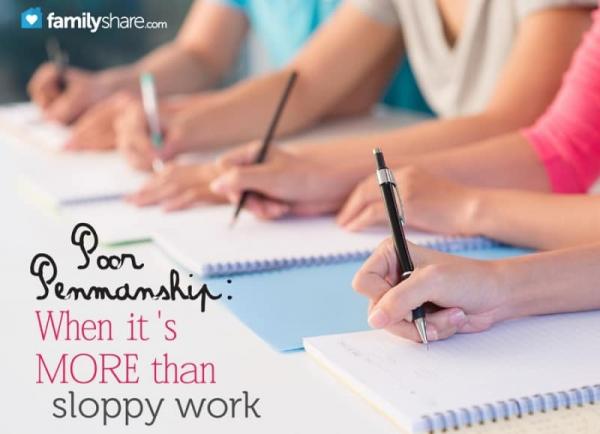
Back when I was a first-time parent, one of the most exciting periods was when my daughter started to learn to write letters and words. Watching her begin to understand the relationship between written symbols and the sounds and words she spoke aloud was truly magical. The letters often had strange spacing, heights, and combinations of upper and lowercase letters, but that didn't matter to me at the time. She was connecting those two big ideas in her brain. I was unconcerned because she had always been (and continues to be) a prolific artist that enjoyed flexing her fine motor skills.
However, when our initial second grade parent-teacher conference came along, her teacher asked if I would be willing to place Lana in "handwriting club"� for extra practice. I now understand that dysgraphia - or a learning disability related to handwriting - is one type of dyslexia. Despite my background in education, it was a disability I had never heard of before. I knew Lana was at risk for dyslexia because my husband is dyslexic. But I had no idea that this brain difference could also impact handwriting. The bigger challenge is that it's not just parents that are unaware of the warning signs of this disability and how to remediate them.Many mainstream preschool, kindergarten, and first-grade teachers are unaware of the signs of this disability, too.
I'm hoping this article will help many parents identify signs of dysgraphia, start to remedy them at home, and - maybe most importantly - pass this information along to preschool and primary teachers so that we can all help kids who suffer from this learning challenge overcome issues sooner rather than later.
What is Dysgraphia?
Per the National Center for Learning Disabilities (NCLD), kids with dysgraphia, "can have trouble organizing letters, numbers, and words on a line or page."�
How your child forms letters matters
When your children are starting to write, make sure to keep an eye on them to ensure they are forming letters from the "sky to the ground."� As soon as he begins to write in preschool, make a $5 investment in Smart Start's Story Paper which will give him visual cues to form letters from the sky to the ground, as well as help him remember the "wormy"� letters that dig under the ground like j, g, p, q, and y.
Make sure your kids are page turners
Depending on whether your child is left-handed or right-handed, she will need to turn the paper to "point"� to her belly button. If she's a "righty," she'll need to turn the paper to the left. If she's a "lefty," she'll need to turn the paper to the right. Because kids in school often look at their classmates' papers to make sure they are "doing it right,"� a left-handed child may assume she is doing it wrong when her paper position doesn't match her classmates'. If you start this process before school, you'll help cement the proper position in her muscle memory before elementary school.
This is one time kids should put an elbow on the table
Or, rather, a forearm. This tip, paired with page positioning, can make sure that kids use the minimum effort possible to move their writing across the page. Their forearms should move like windshield wipers as they draw lines or letters across the page. Their arm shouldn't need to move - the page should. You will be surprised how much this helps with how quickly kids give up on writing tasks.
Get a grip
This is another aspect of handwriting development that is important to address as young as possible. Luckily, there are tripod pencil grips available that can help this process along for under $10 that can be used and reused through elementary school. Triangle pencils and triangular crayons can also help your child practice - and make permanent - proper grip.
For Older Students"�
Info Graphic
Because dysgraphia impacts both letter and number spacing, higher math tasks can quickly become more challenging for older students. Wide-ruled graph paper can prove incredibly helpful to make sure numbers stay in the place (value) where they belong, and the proper numbers are added or subtracted from each other. Another option is to turn normal lined paper from portrait to landscape format to solve math equations. In this way, the ones, tens, and hundreds places - and beyond - always remain where they belong.
Bump it up
Because dysgraphia is often a result of visual-spatial processing problems, buying ridged paper that allows kids to "bump the lines"� gives them a tactile reminder of the bottom and top of each line so that their letters remain in the space where they belong horizontally. Also, the ridged rules on the left and right provide that same tactile reminder vertically of where each line of text should begin and end. This type of paper is also available with visual cues for ensuring that letters that hit the midline - which is most of them - are all formed properly and, most importantly, legibly.
Key into the issue
One of the most popular and most accepted classroom accommodations is simply to bring a laptop into class to take notes or type up papers instead of handwriting them. The challenge is that most teachers will not allow kids to take tests in this manner without a learning plan like an IEP or 504.
Whether you just try a couple of techniques above or start working on the whole gamut, please don't wait to address this learning challenge or assume that it will "work itself out."� I've heard from far too many occupational therapists, special needs teachers, and parents that playing the waiting game adds undue stress not only to your life but to your child. Isn't school stressful enough for kids without adding an unnecessary one to their book bags?

